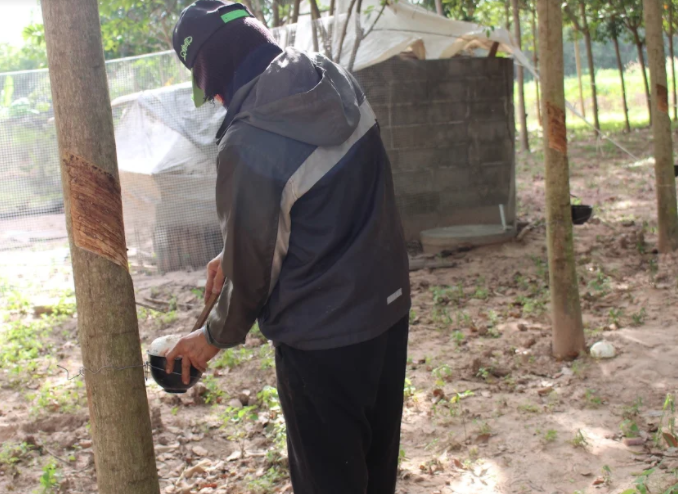Rubber plantation labor and labor movements as rubber prices decrease in southern Thailand
Versions
- 2018-04-26 (2)
- 2018-04-26 (1)

A decrease in rubber prices can initiate labor migration trends from rubber production to industrial or service sectors, which could further cause labor shortages in rubber production. This case was not studied in the different communities with a long history of rubber such as the center city of southern Thailand. This study analyzes the source of labor and movement of laborers working in rubber plantations in the context of decreasing rubber prices. We selected 3 representative areas, namely rural, suburban and urban communities in Hat Yai district, Songkhla province. Owners of rubber holdings were the target group for the survey, and individual interviews were conducted. We collected data between March and July 2015, engaging with 207 owners. The results showed that family labor and hired labor were widely used in rubber plantations in the three communities. Locally hired laborers and laborers from other countries were the main sources of hired labor for rubber plantations. The transnational laborers were a secondary source of labor for all communities, especially the rural ones. Family labor was the main source of labor for smallholder rubber plots, especially for the urban and suburban areas. Hired labor was used in all sizes of rubber holding in rural and suburban communities and were very common in the small rubber holdings in urban areas. This shows that the rubber production sector creates employment for local people and for migrants. Furthermore, low rubber price conditions did not significantly impact labor movement in rubber plantations. However, rubber plantations in urban and suburban communities lacked labor supply due to their proximity to the larger urban center of Hat Yai city. Therefore, the low tapping intensity and generate the diversified source of income to attract young labor generation to work on the farms should be policy to maintain natural rubber production in Thailand
Benjamin, D. (1992). Household composition labor markets and labor demand: testing for separation in agricultural household models. Econometrica, 60 (2): 287-322.
Chambon, B. & S. Gobina Mokoko. (2013). Determinants of the choice of tree crops in diversified farming systems of the rubber smallholders in wouth-west Cameroon. In Tropical Tree Crops. (Ed.) Economical and ecological challenges of diversification. Vrsailles, Quae.
Chevapat, N. (1994). An economic analysis of factors of production in rubber Industry and labour migration: A case study of Trang province. Bangkok, Thailand: Chulalongkorn University. [in Thai]
Kongmanee, C. (2015). Path dependence of agrarian change: an institutional economic analysis of the rubber economy in Southern Thailand. PhD diss., Montpellier SupAgro.
Nobnorb, P & W. Fongsuwan. (2014). Factors affecting free labor movement amongst rubber industry workers within the ASEAN economic community-AEC. Research Journal of Business Management, 8(4): 427-439.
NSO (National Statistical Office). (2015). The average of debt per household by region and province of 1998-2015. Retrieved from service.nso.go.th/nso/web/
statseries/tables/00000_Whole_Kingdom/Table3.xls. [in Thai]
OAE (Office of Agricultural Economics). (2016a). Agricultural Statistics of Thailand 2015. Office of Agricultural Economics, Ministry of Agriculture and Cooperatives, Thailand. [in Thai]
OAE. (2016b). The trend of Thai elder workers in agriculture sector, suggestion to improve labor skill- welfare –technology. News 22/2016, 12 February 2016. Retrieved from http://www.oae.go.th/ewtadmin/ewt/oae_web/ewt_news.php?nid=21823&filename=index_green. [in Thai]
Ruf, F. (1995). From the forest rent to the tree capital; basic laws of cocoa cycles. In Ruf, F. and Siswoputanto, P.S. (Eds.) Cocoa Cycles. The economics of cocoa supply (pp. 1-53). Cambridge: Wood head publishing.
Somboonsuk, B., P. Wettayaprasit, K. Pacheera & P. Kroeksakul. (2011). Comparison of career change and resource management of rubber smallholders. Kasetsart Journal (Social Sciences) 32: 29 – 40.
Tansri, K. (n.d.). Labour Changes in Agriculture Sector of Thailand, Bank of Thailand. Retrieved from https://www.bot.or.th/Thai/.../DocLib.../04-Labor%20with%20Agri%20Changing.pdf. [in Thai]
Thongpan, S. (2014). The incoming of rubber plantation and decision to return home: case study of farm households in Huay Kong basin. Journal of Sociology and Anthropolog, 33(2): 73-102.
Wanasuk, K. J. Kosako & P. Chuawanla. (2014). Household debts in southern Thailand, bank of Thailand. Retrieved from www.bot.or.th/Thai/
MonetaryPolicy/Southern/DocLib/การศึกษาเชิงลึกเรื่อง%20หนี้ครัวเรือนกับเศรษฐกิจภาคใต้.pdf. [in Thai]
Weaving, R. (1994). Revitalizing Tree Crops: Rubber in Thailand. Retrieved from http://documents.worldbank.org/curated/en/410861468132603631/pdf/28493.pdf
Copyright (c) 2019 Forest and Society

This work is licensed under a Creative Commons Attribution 4.0 International License.
This is an open access journal which means that all contents is freely available without charge to the user or his/her institution. Users are allowed to read, download, copy, distribute, print, search, or link to the full texts of the articles in this journal without asking prior permission from the publisher or the author. This is in accordance with the BOAI definition of open access.
Submission of an article implies that the work described has not been published previously (except in the form of an abstract or as part of a published lecture or academic thesis), that it is not under consideration for publication elsewhere, that its publication is approved by all authors and tacitly or explicitly by the responsible authorities where the work was carried out, and that, if accepted, will not be published elsewhere in the same form, in English or in any other language, without the written consent of the Publisher. An article based on a section from a completed graduate dissertation may be published in Forest and Society, but only if this is allowed by author's(s') university rules. The Editors reserve the right to edit or otherwise alter all contributions, but authors will receive proofs for approval before publication.
Forest and Society operates a CC-BY 4.0 © license for journal papers. Copyright remains with the author, but Forest and Society is licensed to publish the paper, and the author agrees to make the article available with the CC-BY 4.0 license. Reproduction as another journal article in whole or in part would be plagiarism. Forest and Society reserves all rights except those granted in this copyright notice







